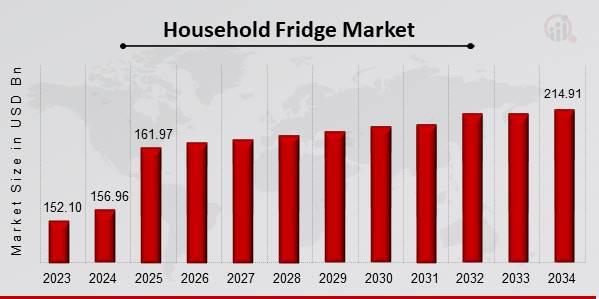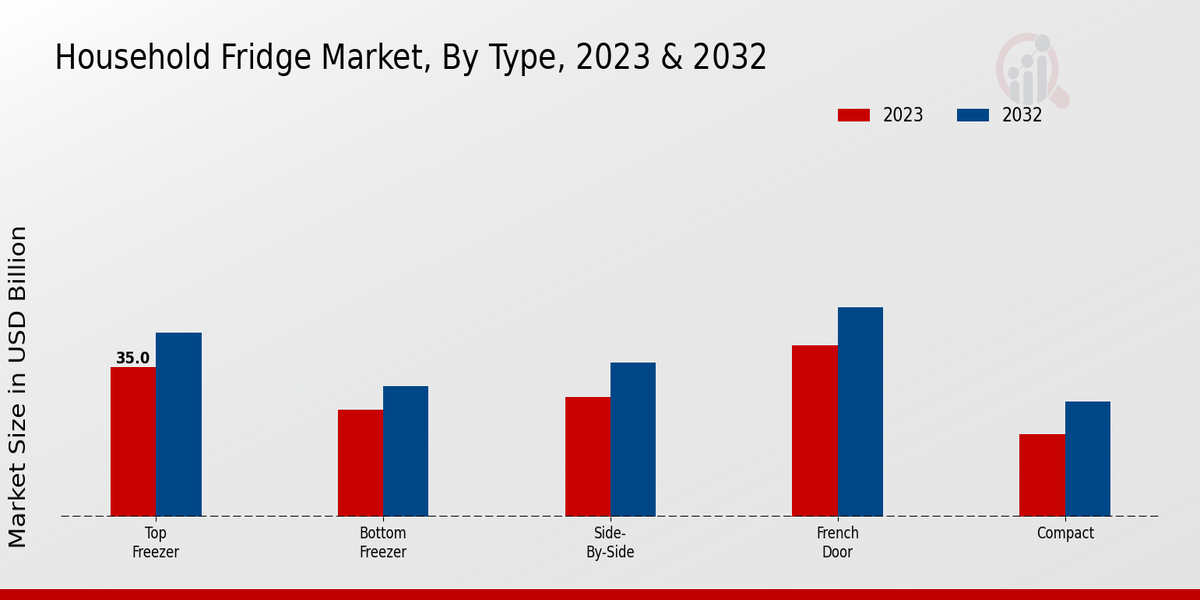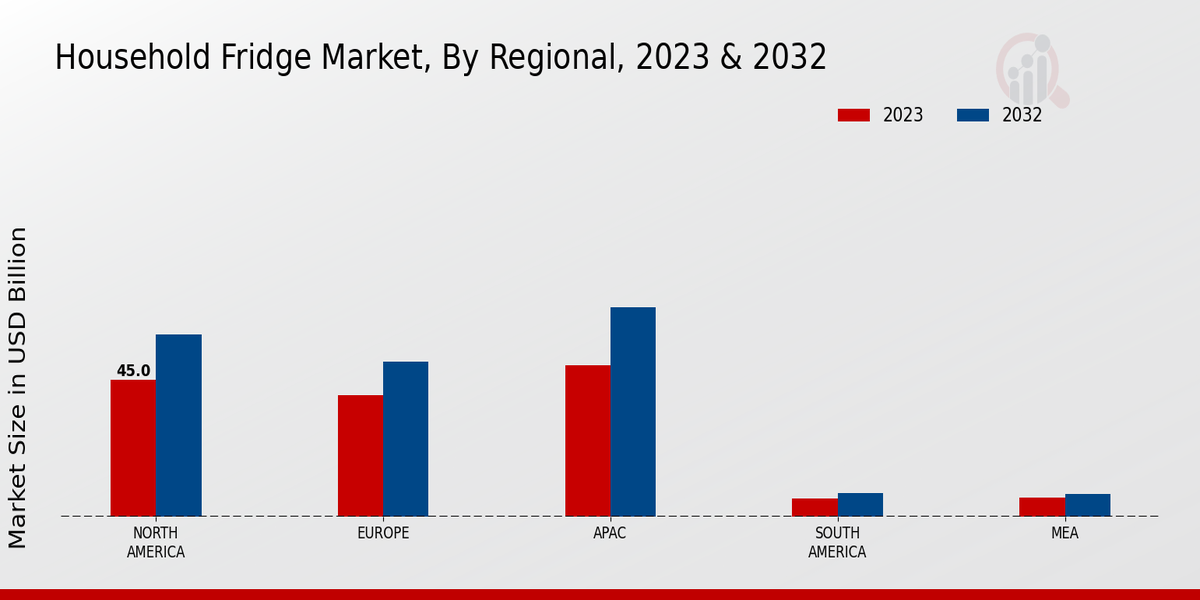Global Household Fridge Market Overview
Household Fridge Market Size was estimated at 156.96 (USD Billion) in 2024. The Household Fridge Market Industry is expected to grow from 161.97 (USD Billion) in 2025 to 214.91 (USD Billion) by 2034. The Household Fridge Market CAGR (growth rate) is expected to be around 3.2% during the forecast period (2025 - 2034).

Source: Primary Research, Secondary Research, MRFR Database and Analyst Review
Key Household Fridge Market Trends Highlighted
The Household Fridge Market is experiencing significant transformation driven by changing consumer preferences, advancements in technology, and growing awareness of energy efficiency. Increasing urbanization and population growth are propelling the demand for modern refrigerators that not only offer better cooling solutions but also incorporate smart technology features. Consumers are increasingly leaning towards energy-efficient appliances, prompted by rising electricity costs and environmental concerns. This shift is leading manufacturers to innovate and produce fridges that meet both functional and ecological needs, thus enhancing their appeal in the market.There are numerous opportunities to be explored in this market, particularly in integrating smart technologies into household fridges. The rise of the Internet of Things (IoT) is paving the way for more intelligent appliances that can communicate with users and other devices. Moreover, the growing trend toward sustainability presents potential for manufacturers to focus on eco-friendly materials and production processes. Additionally, emerging markets are showing a rising demand for refrigerators, especially in developing regions where urban lifestyles are on the rise. This opens doors for businesses to introduce affordable yet efficient products tailored to meet local needs.Recent trends indicate a strong emphasis on consolidation within the market, with companies seeking partnerships and mergers to enhance their technological capabilities. The popularity of multi-door and French-door refrigerators continues to grow, driven by consumer demand for more storage options and convenience. Sustainability is also becoming a key aspect, with manufacturers increasingly adopting green practices and promoting energy-efficient models. As consumer habits evolve, the market is likely to further embrace features that enhance usability, such as touch screens, smart inventory management, and connectivity with kitchen devices. These developments suggest that the landscape of the Household Fridge Market will continue to change, becoming more aligned with the needs and expectations of modern consumers.
Household Fridge Market Drivers
Growing Urbanization and Changing Lifestyles
Urbanization is a significant factor driving the Household Fridge Market Industry as more people move to urban areas, leading to a shift in household dynamics and lifestyle changes. Urban dwellers often have busier schedules and seek solutions that promote convenience and efficiency. The necessity for modern, reliable kitchen appliances has risen with the increase in disposable income and the evolving preferences of consumers who prioritize energy-efficient and technologically advanced fridges.In urban settings, the limited living space heightens the demand for compact yet multifunctional refrigerators that maximize storage while fitting seamlessly into smaller kitchens. Consequently, manufacturers are focusing on creating designs that cater to multitasking needs, such as fridges that incorporate smart technologies, enhancing convenience for modern homeowners. Furthermore, the rise of the nuclear family structure in urban areas has also modified the refrigeration needs, where smaller units could cater to the needs of fewer members or those with minimal cooking requirements.This scenario paves the way for innovations in the market, prompting brands to delve deeper into research and development to offer products that encapsulate these changing demands. As urban spaces become saturated, the proliferation of mini-fridges and energy-efficient models is expected to significantly influence purchasing choices. This trend is likely to propel the overall market's growth as companies adapt to diverse consumer expectations and aesthetics, thereby solidifying their position within the Household Fridge Market.
Technological Advancements in Refrigeration
The Household Fridge Market Industry is experiencing transformation propelled by rapid technological advancements. Innovative features like smart cooling systems, touchscreen interfaces, and Wi-Fi connectivity are becoming commonplace in modern fridges. These advancements not only enhance user experience but also optimize energy consumption, which is a growing concern among environmentally conscious consumers. As manufacturers continuously strive to improve energy efficiency, the availability of eco-friendly refrigerants and advanced insulation materials becomes integral in developing refrigerators that are more sustainable.The integration of AI and IoT is further revolutionizing the market, enabling appliances to inform users about food spoilage, maintenance restrictions, and energy usage through mobile applications, ultimately elevating the overall customer experience. Such innovations contribute to the sustained growth of the Household Fridge Market.
Increased Focus on Energy Efficiency
Energy efficiency is becoming a critical concern among consumers, and this trend is a vital driver for the Household Fridge Market Industry. With rising energy costs and growing awareness of environmental sustainability, many households are looking for appliances that contribute towards lower energy consumption and reduced utility bills. Manufacturers are keen on developing refrigerators that meet strict energy standards and regulations, driving innovations in design and technology aimed at reducing energy use.Fridges with high energy ratings not only appeal to eco-conscious consumers but also play a significant role in overcoming regulations that mandate energy efficiency, which ultimately positions these products favorably in a competitive market.
Household Fridge Market Segment Insights
Household Fridge Market Type Insights
The Household Fridge Market is diverse and categorized into various types that cater to different consumer needs and preferences, which drives significant revenue across the industry. In 2023, the overall market was valued at 147.4 USD Billion, showing a robust consumer interest in different fridge styles. Among the types, the Top Freezer type holds a dominant position, valued at 35.0 USD Billion. This configuration remains popular due to its practical design and accessibility, providing an efficient option for many households. The Bottom Freezer type, valued at 25.0 USD Billion, offers a more ergonomic experience, placing frequently used items at eye level, contributing to its growing significance in the market.The Side-by-Side type fridge is valued at 28.0 USD Billion, featuring a modern design that appeals to consumers seeking convenience and a larger storage capacity. This type often includes advanced features, such as ice and water dispensers, which add to its attraction, particularly among busy families. The French Door type fridge stands out with a valuation of 40.0 USD Billion, offering a sophisticated aesthetic and spacious internal layout, making it a popular choice for larger households that require ample fresh food storage and easy access. Compact fridges, valued at 19.4 USD Billion, serve a niche segment, providing suitable refrigeration alternatives for smaller spaces such as dorms, offices, and apartments, showcasing their importance in urban settings where space is a constraint.Market growth drivers include technological advancements and the rise in consumer awareness regarding energy-efficient appliances, which benefits the entire household fridge segment. The growing middle-class population and urbanization trends further bolster the demand for various fridge types, leading to enhanced Household Fridge Market Statistics and data collection. However, challenges such as rising raw material costs and intense competition may impact pricing strategies and profit margins in the future. Hence, manufacturers are exploring opportunities for innovative designs and smart features to enhance consumer engagement and market positioning. The Household Fridge Market segmentation by type reveals a dynamic landscape where each configuration offers unique benefits catering to differing consumer lifestyles and preferences, providing a comprehensive picture of market trends and opportunities.

Source: Primary Research, Secondary Research, MRFR Database and Analyst Review
Household Fridge Market Technology Insights
The Household Fridge Market revenue for 2023 was valued at 147.4 billion USD, demonstrating a growing demand driven by advancements in technology. Within this market, different technologies cater to various consumer needs and preferences. Conventional units remain popular due to their affordability and reliability, while smart fridges are gaining traction as more households seek interconnected devices for enhanced convenience and monitoring capabilities. Energy-efficient units play a critical role in environmental sustainability, attracting consumers looking to reduce their energy consumption and lower utility bills.Moreover, inverter compressor refrigerators are increasingly favored for their ability to adjust cooling power based on demand, resulting in energy savings and noise reduction. Dual cooling systems also hold significant advantages, offering better temperature control and food preservation. As the market evolves, trends like sustainable practices and smart technology integration continue to shape the Household Fridge Market industry, presenting numerous opportunities for innovation and growth. Overall, the market growth reflects a blend of consumer preferences for efficiency, technology integration, and energy conservation.
Household Fridge Market Capacity Insights
In 2023, the Household Fridge Market was valued at 147.4 USD Billion, reflecting consistent growth driven by evolving consumer preferences and technological advancements. The capacity segment is a significant area of focus, with varied sizes catering to diverse household needs. Categories such as less than 300 liters, 300 to 500 liters, 500 to 800 liters, and more than 800 liters play crucial roles in shaping market dynamics. The segment of 300 to 500 liters is particularly notable as it meets the requirements of an average family size, representing a substantial portion of household purchases.Meanwhile, a capacity of more than 800 liters dominates the market among larger families or those seeking extra storage space, offering convenience and functionality. The continuous demand for energy-efficient refrigerators further influences the segmentation within the Household Fridge Market. Growth drivers include rising disposable incomes and an increasing trend towards smart kitchen appliances, presenting ample opportunities for innovation. Challenges may arise from the rising cost of raw materials and changing regulatory standards affecting the production processes.These factors combine to create a complex yet promising landscape within the Household Fridge Market as emerging technology and consumer demands continue to shape market growth and segmentation.
Household Fridge Market End Use Insights
The Household Fridge Market focuses on different end-use applications, primarily categorized into residential and commercial sectors. In 2023, the overall market was valued at 147.4 USD Billion, showing a robust demand for refrigerators across various applications. The residential end-use segment plays a crucial role in driving market growth as households continually seek efficient and innovative refrigeration solutions to enhance food preservation. On the other hand, the commercial segment reflects a steady demand from businesses such as restaurants and retail outlets, where refrigeration is essential for maintaining perishable inventory.As consumer trends lean towards energy-efficient appliances, the market is witnessing a shift towards models that offer reduced energy consumption and advanced features. Additionally, the rising focus on food safety and longevity supports the consistent demand in both segments, ensuring a significant contribution to the Household Fridge Market revenue. Market statistics suggest that both residential and commercial applications will continue to equally influence the overall market trajectory, catering to the evolving preferences of consumers and businesses alike.
Household Fridge Market Regional Insights
The Household Fridge Market revenue is experiencing substantial growth across various regional segments. In 2023, the North American region dominated the market with a valuation of 45.0 USD Billion, significantly contributing to the overall market dynamics, led by high consumer demand and technological advancements. Europe follows closely behind with a market valuation of 40.0 USD Billion, showcasing increasing energy-efficient appliance trends. The Asia-Pacific (APAC) region is notable for its rapid growth, holding a significant value of 50.0 USD Billion in 2023, driven by urbanization and rising disposable incomes.South America and the Middle East Africa (MEA) hold smaller shares at 6.0 USD Billion and 6.4 USD Billion, respectively; however, both show potential for growth due to increasing access to refrigeration technology. In summary, the Household Fridge Market segmentation reveals North America and Europe as key players, while APAC emerges as a vital growth driver in the industry, supported by changing consumer preferences and market opportunities.

Source: Primary Research, Secondary Research, MRFR Database and Analyst Review
Household Fridge Market Key Players and Competitive Insights
The Household Fridge Market is characterized by a dynamic competitive landscape that reflects the growing demand for energy-efficient and technologically advanced refrigeration solutions. With consumer preferences continuously evolving towards smart appliances, companies are innovating their product offerings to include features such as IoT connectivity, advanced cooling technologies, and enhanced energy-saving modes. Competition is largely driven by the need for distinctive design and functionality, as well as compliance with increasingly stringent regulations concerning energy consumption and environmental impact. As a result, manufacturers are employing various strategies, including product differentiation, strategic partnerships, and mergers and acquisitions, to strengthen their market position and adapt to the shifting demands of consumers, thereby creating a complex yet vibrant market environment.Smeg has established a notable presence in the Household Fridge Market by leveraging its strong brand reputation for stylish and retro-inspired designs that appeal to niche consumer segments. The company is recognized for its commitment to high-quality craftsmanship, innovative features, and energy-efficient solutions. Smeg refrigerators are often characterized by their unique aesthetic appeal, allowing them to stand out in a crowded market. Moreover, the company emphasizes sustainability, producing appliances that incorporate environmentally friendly technologies and materials. This commitment to design excellence and functionality enhances Smeg's market presence, allowing it to carve out a loyal customer base that values both form and function in its household fridges.Samsung is a key player in the Household Fridge Market, known for its cutting-edge technology and diverse range of refrigerator options. The company has gained a competitive edge through innovation, integrating smart technology features such as touchscreen interfaces, smart home connectivity, and advanced food preservation systems into its products. Samsung's refrigerators consistently receive acclaim for their energy efficiency and modern designs, catering to a wide array of consumer preferences. Furthermore, the brand's extensive distribution channels and robust marketing strategies allow it to maintain a strong market presence. By continuously investing in research and development, Samsung seeks to enhance user experience and meet the demands of consumers looking for reliable and high-performance refrigeration solutions.
Key Companies in the Household Fridge Market Include
- Smeg
- Samsung
- Electrolux
- Midea
- Sharp
- GE Appliances
- Whirlpool
- SubZero
- Bosch
- Haier
- Panasonic
- Kenmore
- LG Electronics
- Toshiba
- Frigidaire
Household Fridge Market Industry Developments
Recent developments in the Household Fridge Market have seen significant growth and technological advancements. Major players such as Samsung and LG Electronics are focusing on smart fridge technologies, incorporating IoT for enhanced user convenience and energy efficiency. Meanwhile, companies like Whirlpool and Bosch continue to innovate in energy-saving technologies to meet escalating environmental regulations and consumer demand for sustainability. Midea and Haier are expanding their manufacturing capabilities to cater to growing markets in Asia and Africa, where household appliance penetration remains relatively low. The market is also witnessing an increase in demand for premium and custom-built refrigerators, which brands like SubZero and Electrolux are capitalizing on with their high-end offerings. Notably, recent merger activities within the sector, such as strategic partnerships for supply chain optimization and geographic expansion, include collaborations aimed at improving distribution networks among these key players. The overall market valuation continues to rise as consumers increasingly prioritize modern features in their purchasing decisions, reflecting a broader trend towards home automation and energy-efficient living.
Household Fridge Market Segmentation Insights
Household Fridge Market Type Outlook
- Top Freezer
- Bottom Freezer
- Side-by-Side
- French Door
- Compact
Household Fridge Market Technology Outlook
- Conventional
- Smart
- Energy Efficient
- Inverter Compressor
- Dual Cooling
Household Fridge Market Capacity Outlook
- Less than 300 liters
- 300 to 500 liters
- 500 to 800 liters
- More than 800 liters
Household Fridge Market End Use Outlook
Household Fridge Market Regional Outlook
- North America
- Europe
- South America
- Asia Pacific
- Middle East and Africa
| Report Attribute/Metric |
Details |
| Market Size 2024 |
156.96 (USD Billion) |
| Market Size 2025 |
161.97 (USD Billion) |
| Market Size 2034 |
214.91 (USD Billion) |
| Compound Annual Growth Rate (CAGR) |
3.2% (2025 - 2034) |
| Report Coverage |
Revenue Forecast, Competitive Landscape, Growth Factors, and Trends |
| Base Year |
2024 |
| Market Forecast Period |
2025 - 2034 |
| Historical Data |
2019 - 2023 |
| Market Forecast Units |
USD Billion |
| Key Companies Profiled |
Smeg, Samsung, Electrolux, Midea, Sharp, GE Appliances, Whirlpool, SubZero, Bosch, Haier, Panasonic, Kenmore, LG Electronics, Toshiba, Frigidaire |
| Segments Covered |
Type, Technology, Capacity, End Use, Regional |
| Key Market Opportunities |
Smart fridge integration, Energy-efficient models, Sustainable materials adoption, Customizable storage solutions, Enhanced online shopping experiences |
| Key Market Dynamics |
Increasing energy efficiency standards, Growing demand for smart appliances, Rising health consciousness among consumers, Shift towards eco-friendly materials, and Expansion of online retail channels. |
| Countries Covered |
North America, Europe, APAC, South America, MEA |
Frequently Asked Questions (FAQ) :
The Household Fridge Market is expected to be valued at 214.91 billion USD by 2034.
The expected CAGR for the Household Fridge Market from 2025 to 2034 is 3.2%.
North America holds the largest market share in the Household Fridge Market at 45.0 billion USD in 2023.
The French door-type fridge segment is projected to reach 49.0 billion USD in market value by 2034.
Major players in the Household Fridge Market include Samsung, Electrolux, and LG Electronics, among others.
The Compact fridge segment is valued at 19.4 billion USD in 2023.
The Bottom Freezer fridge segment is expected to grow to 30.5 billion USD by 2034.
The household fridge segment in Europe is projected to be valued at 51.0 billion USD by 2034.
The Side-by-Side fridge segment is expected to grow notably to 36.0 billion USD by 2034.
The market for South America is projected to reach 8.0 billion USD by 2034.

















